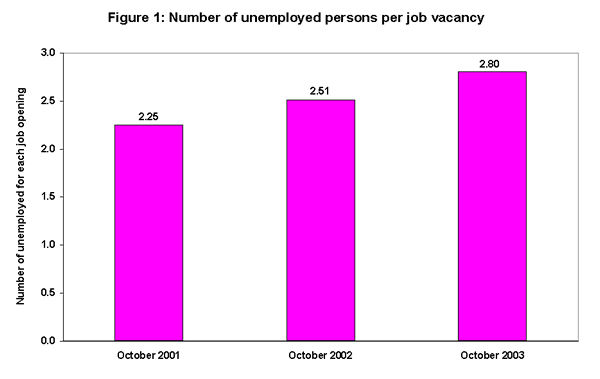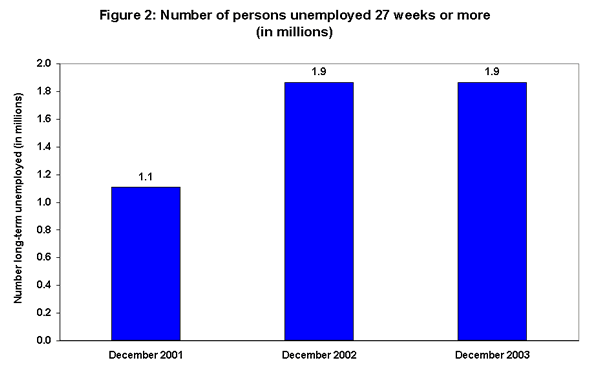See Snapshots Archive.
Snapshot for January 14, 2004.
Economic evidence supports the need for Congress to resume Temporary Extended Unemployment Compensation
Temporary Extended Unemployment Compensation (TEUC) expired on December 21, 2003. Since that date, no new recipients have been eligible for TEUC even though jobs remain elusive for many individuals. The availability of jobs, the number of persons seeking those jobs, and the severity of the nationwide long-term unemployment problem are important economic indicators that provide useful insights into current labor market conditions.
The ratio of unemployed persons to each job opening increased 25% between October 2001 and October 2003 (the latest available data). By October 2003, there were close to three unemployed persons for every job opening (see Figure 1). In November and December 2003, payrolls expanded by only 44,000 jobs, while the working-age population rose by more than half a million. Thus, it has been getting harder, not easier, for the unemployed to find jobs. The unemployment rate fell in December 2003 only because people gave up looking for work, not because more people were finding jobs.

In addition, long-term unemployment has increased by about 70% between December 2001 and December 2003 (the latest available data). As shown in Figure 2, the number of persons out of work for 27 weeks or more hovered around two million in December 2003.

These two figures illustrate the difficulty in finding employment throughout this tenuous economic recovery—especially in terms of opportunities for the long-term unemployed. Recent economic data give us no reason to think that extended unemployment benefits are no longer necessary. Hundreds of thousands of new workers will exhaust their state benefits each month for the foreseeable future with no substantial hope of finding a job. The federal government should act to renew TEUC in response to the prolonged weakness in the labor market.
Notes: Figure 1 was generated by dividing unemployment levels by job openings. Unemployment levels and job openings are Bureau of Labor Statistics (BLS) data that are not seasonally adjusted. Data on job openings are from the BLS Job Openings and Labor Turnover Survey. The series is too short to apply seasonal adjustments. The long-term unemployment series is also BLS data that are not seasonally adjusted for comparison purposes.
This week’s Snapshot was written by EPI economist Sylvia Allegretto.
